Case Studies > Los Angeles Times
The Los Angeles Times onboarded with Recast in September of 2023 to address questions they had around the true incremental impact of their marketing efforts and the portions of their business being driven by paid marketing vs. organic demand.
Since that time, the LA Times has driven serious improvements in marketing performance: paid CPA is down 30-40% YoY while paid media’s share of conversions has increased. But these changes didn’t happen overnight. The LA Times has taken careful steps to stress test their Recast models, validate their output, and build confidence in the platform throughout their organization.
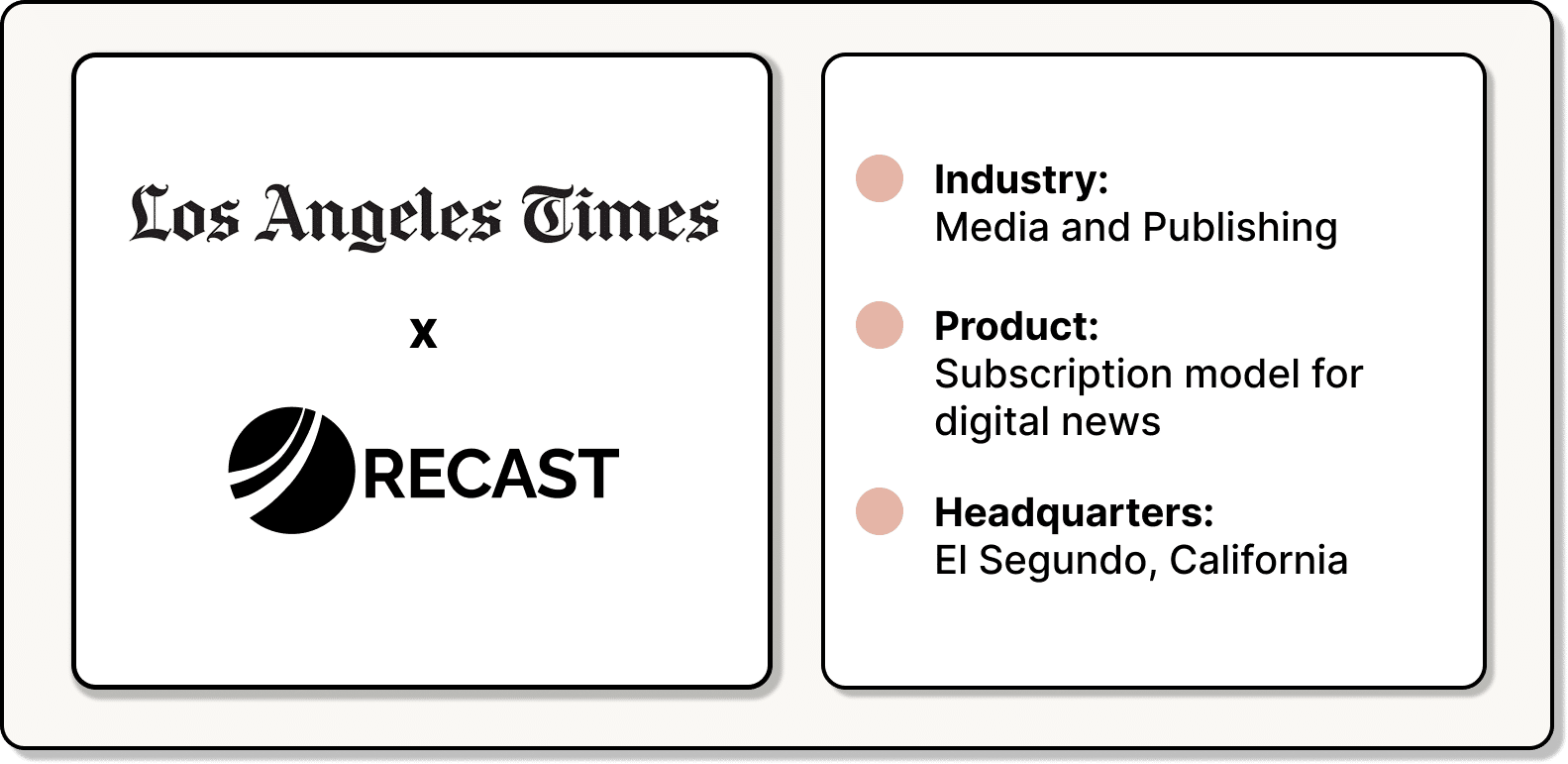
The Los Angeles Times is a daily news institution. Founded in 1881, they are a top-five newspaper in America and the largest in the Western United States.
They’ve launched thousands of marketing campaigns in their 140+ year history, which has built their brand into a household name while creating some real challenges in measuring marketing effectiveness. These reached an inflection point in 2023, as their marketing organization wrestled with a few key questions:
- What is the contribution of paid marketing vs. organic baseline demand?
- What is the incremental CPA of our online and offline media channels?
- How can we build a forecasting process that takes into account seasonality and demand spikes related to viral news stories?
The LA Times onboarded with Recast in September of 2023 to address these concerns and gain a holistic view into marketing effectiveness. Over the last 18 months, they’ve driven serious improvements in marketing performance with the help of the Recast platform.
Paid CPA is down 30-40% YoY while paid media’s share of conversions has increased. The LA Times also hit a major goal of reaching paid LTV:CAC greater than 1.0, and now has a robust forecasting, planning, and experimentation process in place that’s rooted in incrementality.
These changes didn’t happen overnight. The LA Times has taken careful steps to stress test their Recast models, validate their output, and build confidence in the platform throughout their organization.
Recast has consistently passed these tests, earning its place as the LA Times’ trusted platform to operate an incrementality system: an ongoing process of planning, experimentation, model validation and optimization of marketing performance.
Before Recast: Reliance on In-Platform Reporting
The LA Times wrestled with a common problem before onboarding with Recast: they relied on in-platform metrics to assess and forecast marketing performance, despite sensing that something was inherently wrong with these reports.
On one hand, the LA Times knew that in-platform metrics were unable to show them the incremental impact of their marketing efforts. But, even more troubling, they suspected that there was serious double-counting of conversions happening across their media channels.
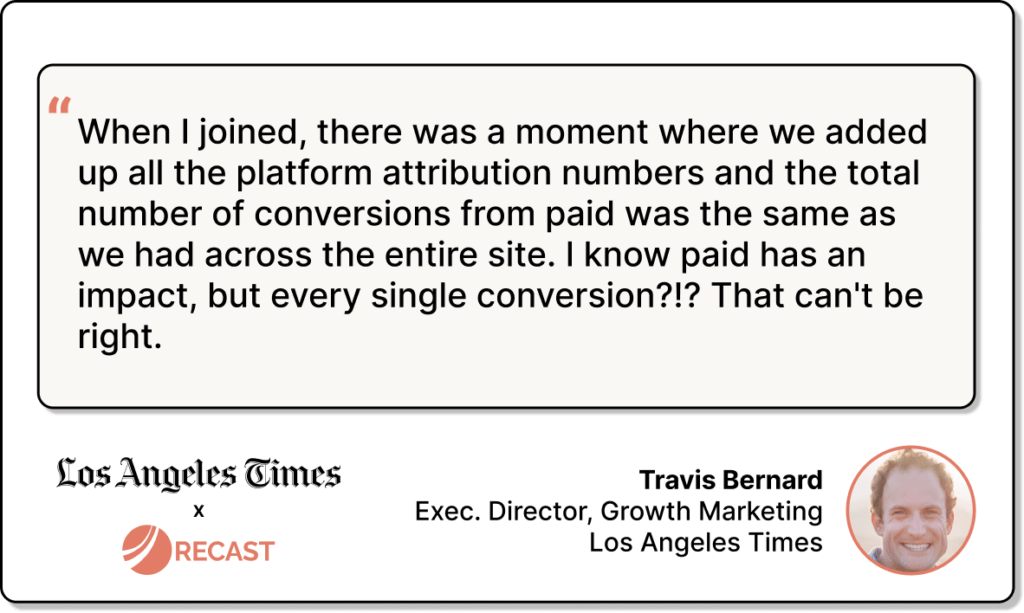
Relying on in-platform metrics had other knock on effects at the LA Times. They had no way to measure the specific interactions between their upper-funnel and lower-funnel channels. For example, how do their upper-funnel activations like a Meta traffic campaign drive consumers to take a lower-funnel action like search for the LA Times on Google?
Their planning process was also rooted in in-platform metrics. It relied on those metrics, the prior year’s budgets, and conversion totals, and did not account for any seasonality in their business.
This all amounted to organizational confusion at the LA Times. They knew they were over-investing in lower-funnel, “performance-driven” channels that were taking too much credit for conversions, but didn’t have the tooling in place to properly test into upper-funnel channels and prove their impact.
Measuring Incrementality with Recast
Things started to change when the LA Times onboarded with Recast in September of 2023. The Recast platform allowed them to measure the incremental impact of each media channel, clearly view the seasonality in their business and understand which conversions were attributable to paid campaigns vs. their organic baseline.
But there were some growing pains. The LA Times was new to media mix modeling (MMM) and needed their organization to embrace a fundamentally new type of marketing measurement. They responded with a thoughtful plan designed to build trust in the Recast platform. They would “stress test” their models, implementing modest budget changes based on Recast’s forecasts and then assessing how accurate those forecasts really were.
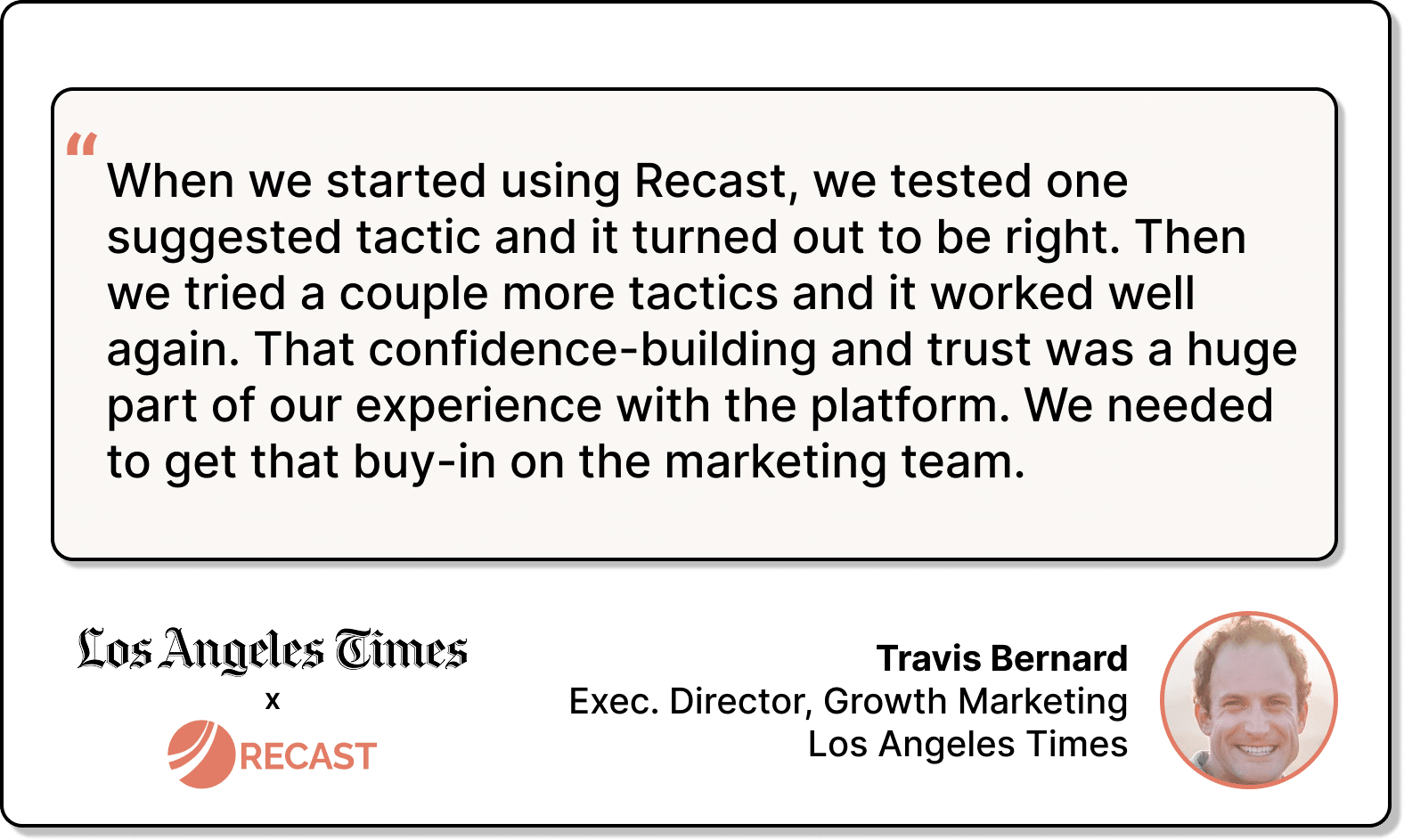
As Recast passed these small stress tests, the LA Times began taking larger swings with the platform’s recommendations. They were impressed with Recast’s robustness and forecast accuracy as larger budget changes went into place, and even brought the platform to their internal data science team and asked them to “poke holes” in the model. The data science team gave Recast a pass with flying colors.

By taking this measured approach to model validation, the LA Times organization built meaningful trust in Recast over time. This was recently put to the test by two exogenous events: the 2024 presidential election and recent wildfires in Los Angeles.
Both events drove large and sustained increases in website traffic, which would have been very easy to attribute to paid media. But Recast properly accounted for these organic spikes in demand, and left the LA Times team even more confident that their models have identified true causal signal between their paid marketing activities and their KPI (acquired subscribers).
Improving Marketing Performance with Recast
The LA Times’ biggest marketing goal in 2024 was reducing paid CPAs for new subscriber acquisitions. With help from Recast, they were able to unlock efficient new marketing strategies that were unavailable to them when relying on touch-based attribution alone.
1) The LA Times was able to test into (and properly measure) the impact of upper funnel traffic campaigns.
Before using an MMM, the LA Times was hesitant to invest in traffic-optimized campaigns. They sensed that these campaigns were having positive impacts on their business, but their gut instincts were not backed up by in-platform metrics from previous attempts.
With Recast, measuring the impact of these campaigns was a very different exercise. The LA Times saw evidence that their historical traffic campaigns were much more incremental than in-platform metrics suggested and decided to run a series of new tests.
This time, they observed the strong incremental performance of their traffic campaigns in Recast, and more, could see the specific impacts that these upper-funnel activations had on the efficiency of lower-funnel channels like branded search.
The LA Times team could now prove the bottom-line impact of their traffic campaigns, which allowed them to unlock more “performance-media” funds for these types of activations.

2) With Recast, the LA Times cut spend from channels that historically looked strong in-platform, but were not driving incremental customer acquisition.
The LA Times was investing a healthy portion of their marketing budget into programmatic display, which looked great in-platform despite the marketing team’s suspicion that the channel was not very performant.
Recast confirmed these suspicions. Some programmatic display tactics were far less incremental than in-platform metrics signaled and the LA Times improved blended paid CPAs by reducing spend in those channels.
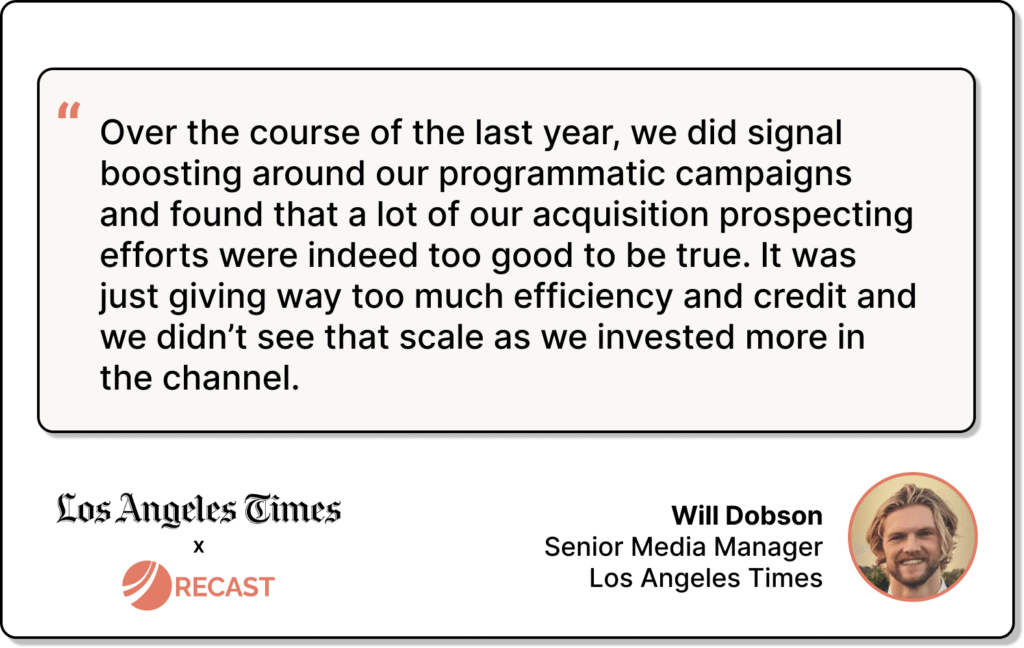
3) The LA Times built an experimentation roadmap with Recast in order to calibrate their models and improve the platform’s recommendations.
In addition to the “stress tests” that the LA Times routinely subjects Recast to, they also design experiments for channels with relatively high uncertainty in their model. This improves the signal that Recast receives for these channels, and over time, yields stronger recommendations from the platform’s Optimizer and Forecaster tools – both heavily used by the LA Times.
Compounding optimizations, new marketing tactics and a well-calibrated media mix model have all helped the LA Times drive transformational improvements in the efficiency of their marketing program. Paid CPAs are down 30-40% as the LA Times kept new subscriber acquisitions steady YoY.
Looking Ahead with Recast
What’s next for Recast and the LA Times? More of the same.
The LA Times team remains laser-focused on improving LTV:CAC and plans to continue stress testing Recast to maintain their confidence in the platform as they follow its recommendations.
They’re also excited to get their hands on the new Recast GeoLift platform, which will help fuel their experimentation roadmap in 2025, and potentially, expansion into new geographies.
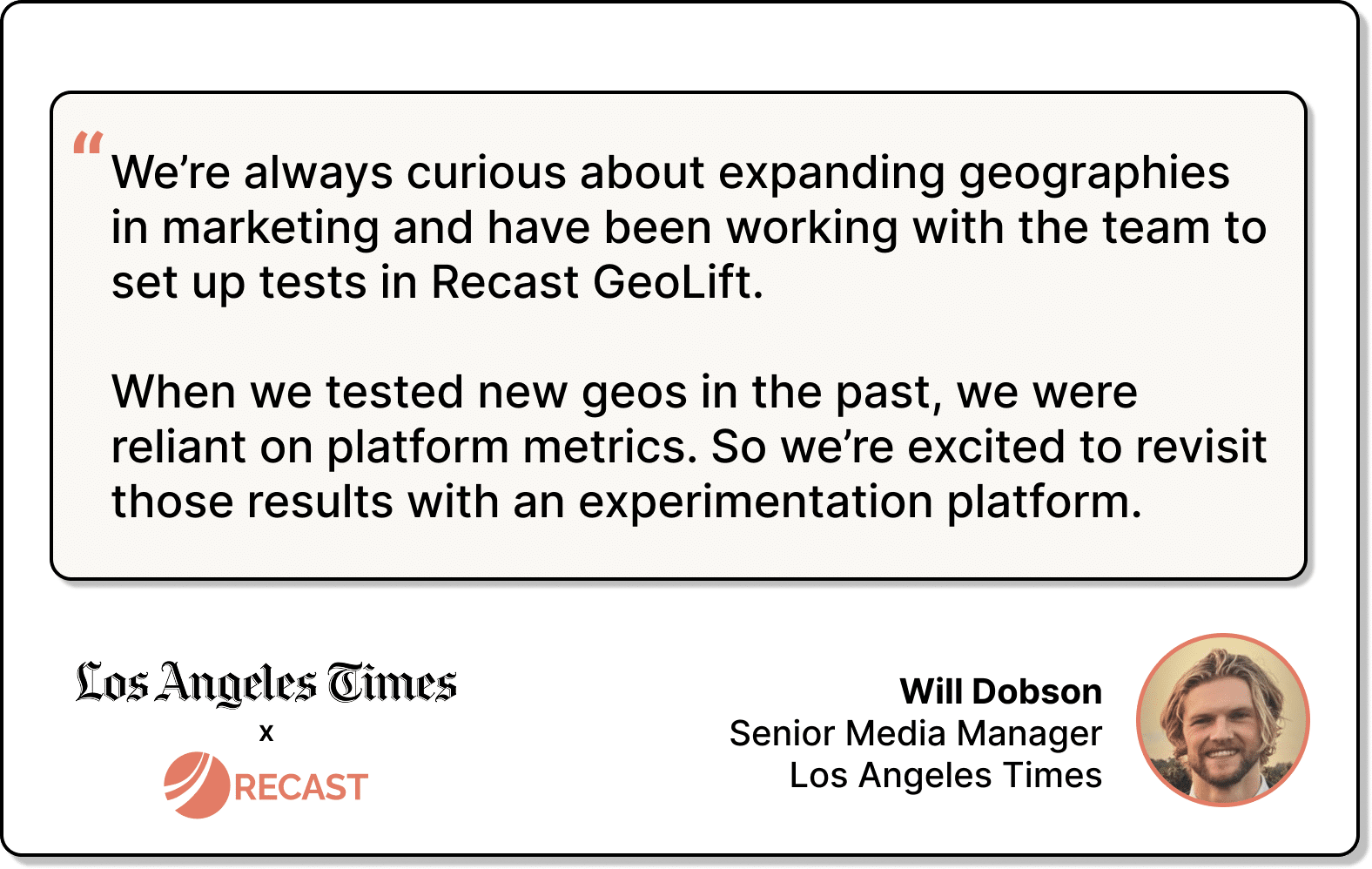
Do you have a complex business like the LA Times and want to work with a best-in-class incrementality platform? We’d love to talk.